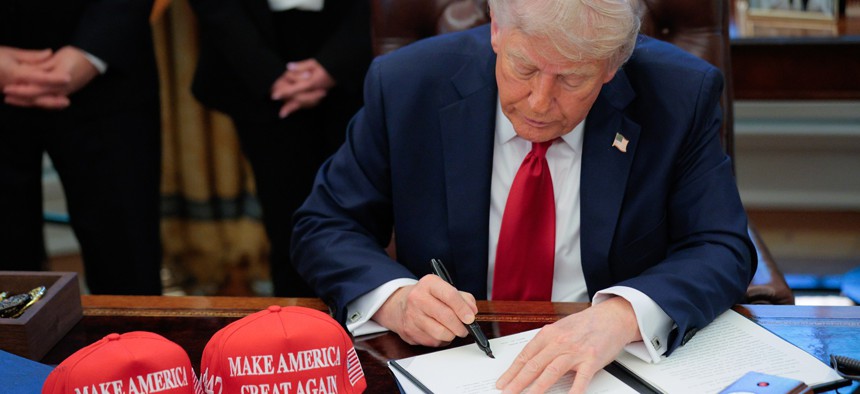Trump unveils sweeping order to bring AI into US education

President Donald Trump signs an executive order in the Oval Office at the White House on April 23, 2025 in Washington, DC. Chip Somodevilla/Getty Images
The executive order forms a new task force and leverages existing grant programs focused on improving AI education in the U.S.
The White House released a new executive action on Wednesday that aims to bring education in artificial intelligence technologies and tools to schools at the K-12 level through the creation of a new task force and allocation of federal grant programs to support the expansion of AI curricula.
The “Advancing Artificial Intelligence Education for American Youth” executive order is the latest Trump administration policy aimed at ensuring American competitiveness in technological and digital subject matter, in part by investing in educators to equip them with suitable materials for both teaching about AI systems and incorporating them into classrooms.
“To ensure the United States remains a global leader in this technological revolution, we must provide our Nation’s youth with opportunities to cultivate the skills and understanding necessary to use and create the next generation of AI technology,” the order said.
Teacher training in AI education curricula will precede student training, with a focus on the need for both comprehensive early exposure to fundamental AI education as well as ensuring education resources in emerging technical fields are available for “lifelong learners.”
“By establishing a strong framework that integrates early student exposure with comprehensive teacher training and other resources for workforce development, we can ensure that every American has the opportunity to learn about AI from the earliest stages of their educational journey through postsecondary education, fostering a culture of innovation and critical thinking that will solidify our Nation’s leadership in the AI-driven future,” the order said.
Central to accomplishing this vision is the creation of a new Artificial Intelligence Education Task Force. Members of the task force will include federal leaders like the secretary of Agriculture; the secretary of Labor; the secretary of Energy; the secretary of Education; the director of the National Science Foundation; the assistant to the president for domestic policy; the special advisory for AI and crypto; the assistant to the president for policy; and the heads of other executive departments and agencies.
The director of the Office of Science and Technology Policy will serve as the chair of the task force and has the power to add members at their discretion.
The task force now has 90 days following the release of the order to make plans for a Presidential Artificial Intelligence Challenge. Set to be held within 12 months of that initial plan’s submission, the AI Challenge will spotlight educator and student work in AI education and promote new AI education curricula across the country.
The challenge will also promote collaboration between government and academic sectors, as well as philanthropic and industry partners.
The order also noted that the administration will announce public-private partnerships to expand access to AI education on a rolling basis as they are formed.
Following the pending announcement of the public-private partnership, the task force is directed to have the resources of these collaborations ready to deploy to schools within 180 days of the formation of the partnerships.
Other 90-day deadlines set by the order ask that the task force identify existing federal programming to expedite the inclusion of AI literacy into the U.S. education system.
The secretary of Education is also specifically directed to issue new guidance within the 90-day timeframe on using discretionary grant funds to improve education outcomes using various AI tools, as well as identify areas where the government can leverage existing federal research programs to help state and local governments incorporate more AI into their education systems.
At the 120-day mark, the Education secretary will also be required to “take steps” to prioritize using AI in discretionary grant programming for teacher training on AI. Some of the target areas where the order envisions AI as a tool for teachers are reducing time-intensive administrative work, improving teacher training and evaluation and offering professional development in fundamental computer science and AI concepts.
The order also aims to bring AI courses to U.S. high schools through priority grant awards and engagement with state and local workforce development boards to incorporate AI-centric education and certification frameworks within that 120-day timeframe.
Some advocacy groups have already voiced their support for expanded education opportunities in AI.
“AI in education is more than just a student hack to write a quick essay. It’s a tool that’s reshaping the American economy and that students will need to become proficient in,” said Americans for Responsible Innovation President Brad Carson in a statement to Nextgov/FCW. “Today’s executive order is a start. While states have traditionally led on education policy, there’s an important role for the federal government to play in providing guidance on how school districts across the country can help students prepare for an AI-powered economy.”
It is unclear how this new order will be impacted by Trump’s March 20 executive order calling for the Education Department to be dismantled and its authority turned over to state and local governments.






